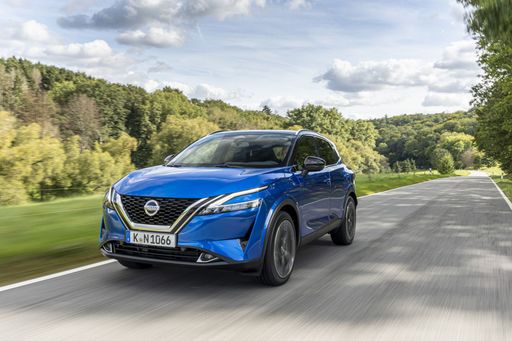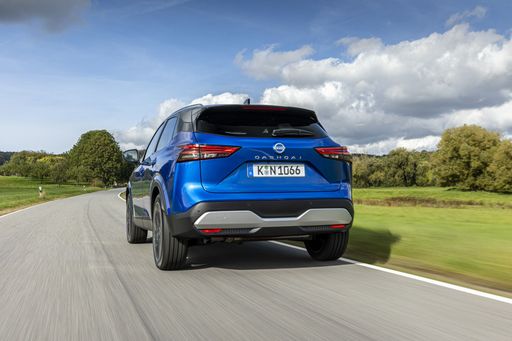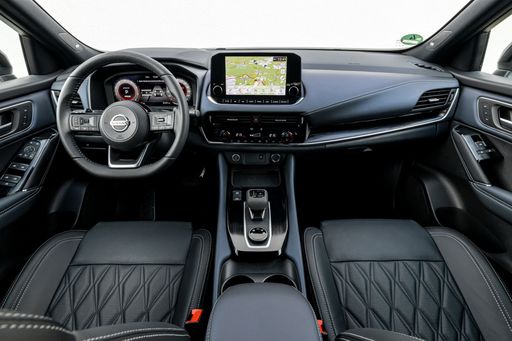Alfa Romeo Junior vs Nissan Qashqai – Który samochód bardziej do Ciebie pasuje?
Dwa auta, jedno starcie: Alfa Romeo Junior kontra Nissan Qashqai.
Które wypada lepiej pod względem osiągów, zużycia i relacji ceny do jakości? Sprawdź teraz!
The automotive market is a vibrant battleground, especially in the SUV segment where models like the Alfa Romeo Junior and Nissan Qashqai are fighting for supremacy. Both vehicles cater to the modern driver's need for versatility, style, and performance. In this article, we will delve into a comprehensive comparison of these two remarkable SUVs, focusing on their technical specifications and innovative features.
Design and Dimensions
The Alfa Romeo Junior boasts a compact yet bold silhouette measuring 4,173 mm in length, 1,781 mm in width, and standing at a height of 1,533 mm. Its design is unmistakably Italian, featuring sleek lines and an aggressive stance that highlights its sporty nature.
On the other hand, the Nissan Qashqai is slightly larger, measuring 4,425 mm in length and 1,835 mm in width, with a height of 1,625 mm. This added size translates into a roomier cabin and a more commanding presence on the road. While the Qashqai treads a more conventional design path, it still exudes a modern aesthetic with sharp angles and a refined appearance.
Power and Performance
The Alfa Romeo Junior offers a variety of engine options, including a standout electric variant with a driving range of up to 410 km. The petrol MHEV versions come with power outputs ranging from 136 HP to an impressive 280 HP. Performance-wise, it can accelerate from 0 to 100 km/h in as little as 5.9 seconds, showcasing its sporty DNA.
In comparison, the Nissan Qashqai’s engine lineup also includes petrol MHEV and full hybrid options, producing between 140 HP and 190 HP. It achieves a 0 to 100 km/h time of 7.9 seconds, offering swift performance, though slightly less aggressive than the Junior's best-in-class acceleration.
Fuel Efficiency and Emissions
Efficiency is a pivotal consideration for buyers today. The Alfa Romeo Junior shines in this category, with fuel consumption figures as low as 4.5 L/100km for petrol variants, alongside its electric models consuming 15.2 kWh/100km. This translates to lower CO2 emissions, with values reaching as low as 0 g/km in the electric version, promoting a greener footprint.
The Nissan Qashqai, while not as efficient as the Junior, still holds its own with a respectable consumption ranging from 5.1 to 6.8 L/100km. Its emissions range from 116 g/km, showcasing an environmentally conscious design but still trailing behind the Junior in terms of sustainability.
Interior and Technology
Inside, both SUVs are equipped to impress. The Alfa Romeo Junior comes with a modern cabin designed with high-quality materials, ergonomics, and a suite of tech innovations. The vehicle features an automatic transmission across its range with options for dual-clutch systems, enhancing driver engagement and efficiency.
The Nissan Qashqai rises to the occasion with a spacious interior laden with modern technology, including an intuitive infotainment system and driver-assist features. It offers both manual and automatic transmission options, giving drivers the choice based on their preferences.
Practicality and Comfort
Practicality is another strong suit for both models. The Junior provides a trunk capacity of 400 liters, a respectable amount for everyday use. Meanwhile, the Qashqai excels in this aspect with a trunk capacity of 504 liters, making it a more suitable option for families or those needing more cargo space.
Both vehicles comfortably accommodate five passengers, and the variety of configurations in both models provides choices for different lifestyles and preferences.
Conclusion
In the battle between the Alfa Romeo Junior and the Nissan Qashqai, both SUVs bring something unique to the table. The Junior captivates with its striking design, sporty performance, and impressive efficiency. Meanwhile, the Qashqai champions practicality and a wealth of technology, making it a solid choice for family-oriented buyers.
Ultimately, your choice between these two will depend on whether you prioritize performance and style or practicality and technology. Whichever you choose, both models represent the continuing evolution of the SUV segment, catering to diverse needs and tastes in today’s automotive landscape.
Szczegóły techniczne: konkretne różnice między modelami
Koszty i zużycie: Porównanie ceny i zużycia paliwa często pokazuje największe różnice. Tu decyduje się, który model lepiej pasuje do budżetu.
Alfa Romeo Junior ma w niewielkim stopniu przewagę cenową – jego cena zaczyna się od 131600 zł, podczas gdy Nissan Qashqai kosztuje 150600 zł. Różnica wynosi około 19065 zł.
Różnice widać również w spalaniu: Alfa Romeo Junior zużywa 4.80 L i jest minimalny oszczędniejszy niż Nissan Qashqai, który spala 5.10 L. To około 0.30 L różnicy na 100 km.
Silnik i osiągi: Moc, moment i przyspieszenie to klasyczne parametry, na których skupiają się entuzjaści – tu widać ciekawe różnice.
Pod względem mocy silnika Alfa Romeo Junior ma wyraźny przewagę – 280 KM zamiast 190 KM. To różnica około 90 KM KM.
W przyspieszeniu 0–100 km/h Alfa Romeo Junior jest czytelny szybszy – 5.90 s wobec 7.90 s. Różnica wynosi około 2 s sekundy.
Prędkość maksymalna jest identyczna – oba auta osiągają 206 km/h.
Różnica widoczna jest również w momencie obrotowym: Alfa Romeo Junior ciągnie prawie niezauważalny mocniej – 345 Nm wobec 330 Nm. Różnica to około 15 Nm.
Przestrzeń i praktyczność: Samochód rodzinny czy codzienny towarzysz – który oferuje więcej miejsca, komfortu i elastyczności?
Oba samochody oferują miejsce dla 5 osób.
Pod względem masy własnej Alfa Romeo Junior jest minimalny lżejszy – 1380 kg wobec 1420 kg. Różnica to około 40 kg kg.
Pod względem pojemności bagażnika Nissan Qashqai oferuje trochę więcej miejsca – 504 L wobec 415 L. To różnica około 89 L litrów.
Pod względem maksymalnej pojemności ładunkowej Nissan Qashqai wypada trochę lepiej – do 1447 L, czyli o około 167 L więcej niż Alfa Romeo Junior.
Pod względem ładowności Nissan Qashqai wypada lekko lepiej – 520 kg wobec 420 kg. Różnica to około 100 kg kg.
Nasza konkluzja: Alfa Romeo Junior okazał się ma niewielką przewagę i tym samym zdobywa tytuł DriveDuel Champion!
W tym porównaniu Alfa Romeo Junior to bardziej wszechstronny wybór.
Alfa Romeo Junior
Junior to zwinny hatchback, który idealnie sprawdza się w miejskich warunkach. Jego nowoczesny design oraz oszczędny silnik przyciągają uwagę młodych kierowców, szukających subtelnego połączenia stylu i funkcjonalności. Dzięki przestronnej kabinie i intuicyjnemu interfejsowi, podróżowanie Junior'em staje się przyjemnością zarówno w codziennych dojazdach, jak i dłuższych trasach.
szczegóły @ media.stellantis.com
@ media.stellantis.com
 @ media.stellantis.com
@ media.stellantis.com
 @ media.stellantis.com
@ media.stellantis.com
Nissan Qashqai
Nissan Qashqai to jeden z najpopularniejszych crossoverów na rynku, który łączy w sobie nowoczesny design z funkcjonalnością. Jego przestronne wnętrze i zaawansowane technologie sprawiają, że podróżowanie staje się zarówno komfortowe, jak i bezpieczne. Qashqai oferuje również wydajne silniki, co czyni go atrakcyjnym wyborem dla tych, którzy szukają samochodu do codziennych dojazdów.
szczegóły @ Nissan
@ Nissan
 @ Nissan
@ Nissan
 @ Nissan
@ Nissan
 @ Nissan
@ Nissan
 @ Nissan
@ Nissan

|

|
|
|
|
Koszty i Zużycie |
|
|---|---|
|
Cena
131600 - 213100 zł
|
Cena
150600 - 218000 zł
|
|
Zużycie L/100km
4.8 - 5.4 L
|
Zużycie L/100km
5.1 - 6.8 L
|
|
Zużycie kWh/100km
15.1 - 17.5 kWh
|
Zużycie kWh/100km
-
|
|
Zasięg elektryczny
344 - 410 km
|
Zasięg elektryczny
-
|
|
Pojemność baterii
0.4 - 51 kWh
|
Pojemność baterii
-
|
|
CO2
0 - 119 g/km
|
CO2
116 - 154 g/km
|
|
Pojemność zbiornika paliwa
44 - 45 L
|
Pojemność zbiornika paliwa
55 L
|
Wymiary i Nadwozie |
|
|---|---|
|
Typ nadwozia
SUV
|
Typ nadwozia
SUV
|
|
Miejsca siedzące
5
|
Miejsca siedzące
5
|
|
Drzwi
5
|
Drzwi
5
|
|
Masa własna
1380 - 1689 kg
|
Masa własna
1420 - 1665 kg
|
|
Pojemność bagażnika
340 - 415 L
|
Pojemność bagażnika
479 - 504 L
|
|
Długość
4173 mm
|
Długość
4425 mm
|
|
Szerokość
1781 mm
|
Szerokość
1835 mm
|
|
Wysokość
1505 - 1538 mm
|
Wysokość
1625 mm
|
|
Maksymalna pojemność bagażnika
1205 - 1280 L
|
Maksymalna pojemność bagażnika
1422 - 1447 L
|
|
Ładowność
390 - 420 kg
|
Ładowność
466 - 520 kg
|
Silnik i Wydajność |
|
|---|---|
|
Typ silnika
Elektryczny, Mild Hybrid Benzyna
|
Typ silnika
Mild Hybrid Benzyna, Pełna Hybryda
|
|
Skrzynia biegów
Automatyczna
|
Skrzynia biegów
Manuel, Automatyczna
|
|
Szczegóły skrzyni biegów
Automatyczna dwusprzęgłowa, Reduktor
|
Szczegóły skrzyni biegów
Manualna skrzynia biegów, Skrzynia CVT, Reduktor
|
|
Rodzaj napędu
Napęd na przednie koła, Napęd na cztery koła
|
Rodzaj napędu
Napęd na przednie koła, Napęd na cztery koła
|
|
Moc KM
136 - 280 KM
|
Moc KM
140 - 190 KM
|
|
Przyspieszenie 0-100km/h
5.9 - 9.1 s
|
Przyspieszenie 0-100km/h
7.9 - 10.2 s
|
|
Maksymalna prędkość
150 - 206 km/h
|
Maksymalna prędkość
170 - 206 km/h
|
|
Moment obrotowy
230 - 345 Nm
|
Moment obrotowy
240 - 330 Nm
|
|
Liczba cylindrów
3
|
Liczba cylindrów
3 - 4
|
|
Moc kW
100 - 207 kW
|
Moc kW
103 - 140 kW
|
|
Pojemność silnika
1199 cm3
|
Pojemność silnika
1332 - 1497 cm3
|
Ogólne |
|
|---|---|
|
Rok modelowy
2024 - 2025
|
Rok modelowy
2024
|
|
Klasa efektywności CO2
A, C, D
|
Klasa efektywności CO2
E, D
|
|
Marka
Alfa Romeo
|
Marka
Nissan
|
Jakie rodzaje napędu ma Alfa Romeo Junior?
Dostępne wersje obejmują Napęd na przednie koła albo Napęd na cztery koła.
Wyświetlane ceny i dane są szacunkowe, oparte na niemieckich cenach katalogowych i mogą się różnić w zależności od kraju. Te informacje nie stanowią wiążącej oferty.
